ETS Training material
The core in ETS is the victim banks. The trauma victim banks consists of patients that can be used through the whole medical chain, from the incident site into the Hospital. All victims come with management cards.
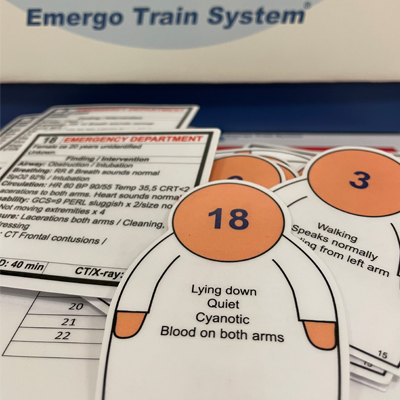
Trauma patient
The patient has text on both the front and back side. On the front side is information that you can see or hear from a distance. For example, the patient is lying down and is quiet. On the back is information that you discover after examining the patient. This text is in accordance with the ATLS®/PHTLS®/TNCC® program; A=Airway, B=Breathing, C=Circulation, D=Disability, and E=Exposure.
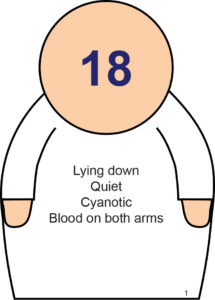
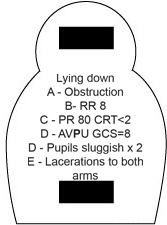
Management card
All victims in the victim bank have an individual management card. The card is used when they arrive in the hospital. On the front page is information about the treatment(s) the patient is given in the Emergency department and the time it will take. Also included is a description of CT/X-ray result and time at X-ray department.
If the patient needs surgery or ICU this information is provided on the back side of the management card where you also can find time at Post-op.
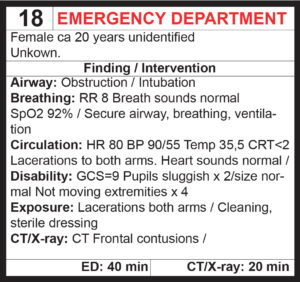
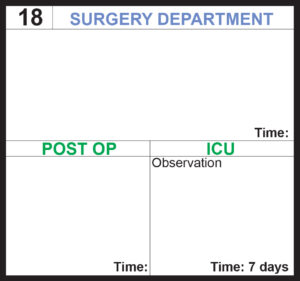
Patient outcome
All ETS patients are categorized into different patient outcome categories. Depending on what intervention is made and within what time after the injury, the patient risk preventable complication or preventable death. The patient outcome template is included in all trauma victim banks.
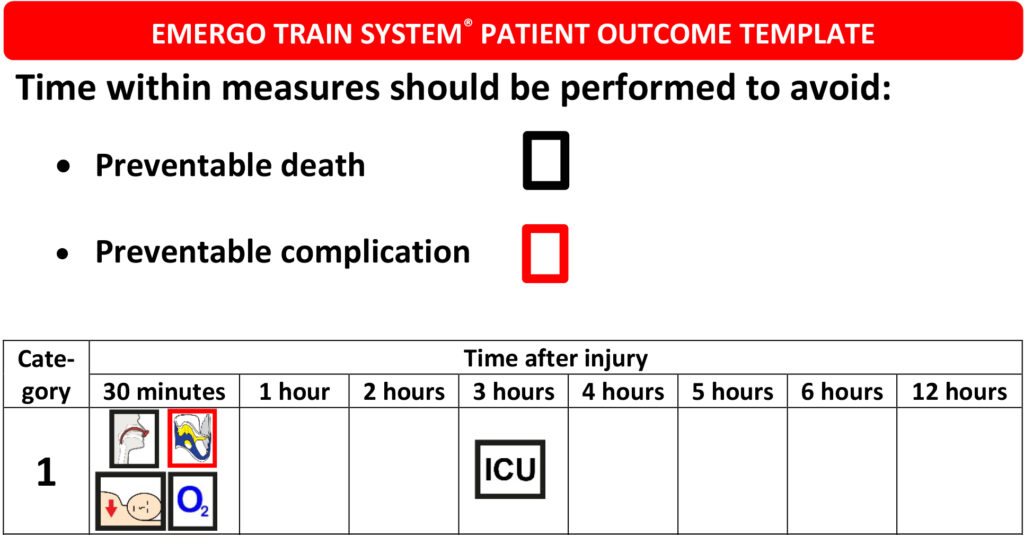
Victim banks
There are several different victim banks to choose depending on what exercises to conduct. All victim banks includes patient outcome template and templates to sort out patients from the victim bank based on patient outcome category. Some victim banks also include extra treatment stickers.
Trauma victim bank
Victim bank with general trauma injuries. Available in large 200 patients (1-200), medium 100 patients (1-100) and small 50 patients (1-50).
Burn trauma victim bank
Consists of patients with various degree of burn injuries and is developed for the purpose of running simulation exercises were the scenario results in a number of patients with burn injuries. Also included in this set is markings for interventions of sitting position and escarotomy.
Available in medium 100 patients (401-500) and small 50 patients (401-450).
Penetrating trauma victim bank
Consists of patients with various degrees of penetrating trauma due to for example gun shot and stab wounds. The injury that the patient sustained requires specific interventions that should be performed by the right resource within the correct time frame calculated from the time of injury. The penetrating trauma victim bank includes, in addition to other categories, also the patient outcome categories:
23 – penetrating thorax injury
24 – penetrating neck injury
25 – severe extremity bleeding
Extra sheets of treatment markings/stickers is included in the penetrating trauma victim bank.
Available in medium 100 patients (501-600) and small 50 patients (501-550).
Bomb/blast trauma victim bank
Consist of patients with for example crush injuries, vascular injuries, contusions, intestinal injuries etc. Example of scenarios to use this victim bank is terror attack, war scenarios, different types of accidents where explosions can occur. The victims are divided into primary, secondary and quarternary injuries correlated to the distance of the energy source. The bank includes most of the regular ETS patient outcome categories 1 to 25.
Available in medium 100 patients (701-800) and small 50 patients (701-750).
Pediatric trauma victim bank
Consists of pediatric patients, from infants up to 17 years old, with different trauma injuries such as for example crush injuries, penetrating injuries, vascular injuries, contusions, intestinal injuries, different types of fractures and wounds.
The pediatric trauma victim bank can be used as a complement to other ETS victim banks when you need pediatric vitims to a scenario. The victim bank can also be used to conduct surge capacity exercises at children hospital.
The time within measures should be performed to avoid preventable death or complication is lower for children and depends on the age of the child. The pediatric patient outcome categories are the same as for adults, but have subcategories depending on the age of the child. A pediatric category start with P in front of the category number and the subcategories are a, b and c. Category P-a are children 0-1 year, P-b are children 2-4 years and P-c children 5-12 years. Children over 12 years are evaluted according to adult categories. There is a special template for pediatric patient outcome evaluation included in the victim bank. There are also templates to sort out patients from the victim bank based on patient outcome category or age.
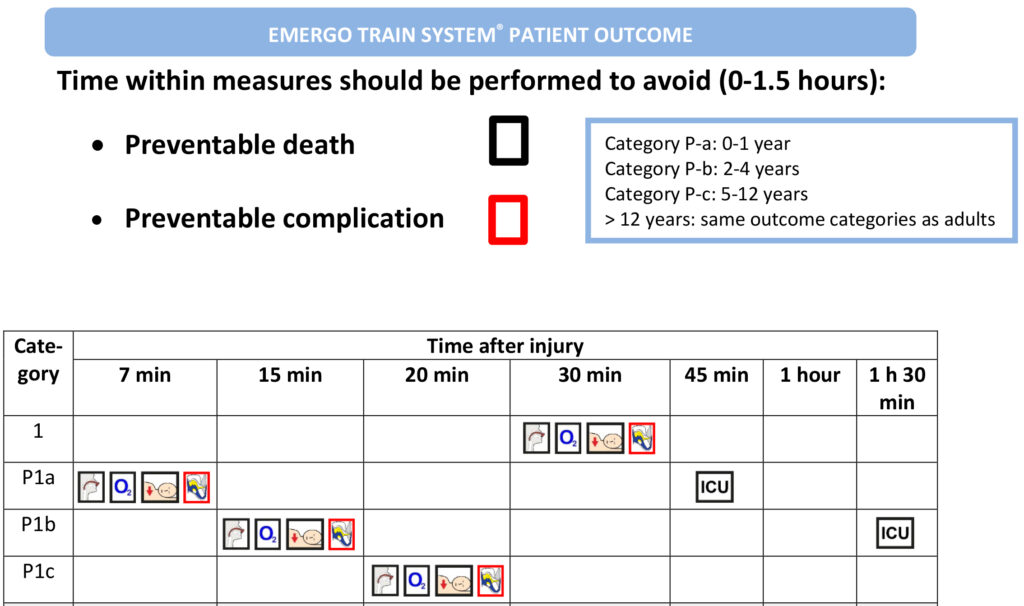
Available in medium 100 patients (601-700) and small 50 (601-650) patients.
Uninjured/psychological shock victim bank
During a pre-hospital scenario with an incident, you might want to include victims that don’t have any physical injuries and/or is in psychological shock. Those victims are triaged green on an incident site and do not need any medical intervention on scene or in a hospital. For this reason they do not have any management card. However they require resources in form of for example, transportation.
Available in medium 50 patients (301b-350b) and small 25 patients (301b-325b).
Trigger victim bank
The trigger victimbank can be used by the ETS instructor to add in an exercise. Those patients are not from the incident, they arrive with an ambulance or is coming from another department in the hospital. All trigger patients starts with a T. The trigger patients can be used as injects during an exercise. For example if the instructors want to add extra workload toa hospital, they can add trigger patients arriving in an ambulance.
The trigger patients also have a management card and need treatment in the same way as the other patients.
The trigger victims are categorized in the same way as the other patients. Some of the trigger patients are categorized in patient outcome categories and are evaluated according to the patient outcome template. Others have in-hospital evaluation outcomes and are evaluated according to the in-hospital patient evaluation.
Available in one size of 50 patients (T1-T50).
Figurant cards
The ETS figurant cards can be used when conducting pre-hospital exercsies using figurants acting injured. The cards can also be combined with an exercise using ETS magnetic patients.
The front side of the figurant card illustrates what the medical staff see and hear on a distance before examining the patient. The back side of the card illustrates the information the medical staff will find when examine the patient. On the back side is also a photo of the injury and also instructions for the figurant of how to act.
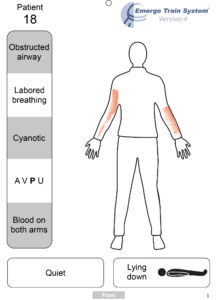
All the figurant cards are based on the data in the Emergo Train System version 4 trauma bank and each figurant card corresponds to a magnetic symbol. This makes it possible to continue an exercise from a pre-hospital exercise using figurants, to an in-hospital setting using magnetic patients and whiteboards. Simply transfer the measures made on the figurant to the magnetic patient by adding stickers on the patient symbol! Patient outcome can then be evaluated all the way from incident site in to hospital.
Available in medium (trauma patient 1-100) and small (trauma patient 1-50).
